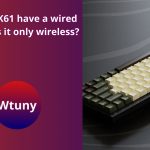A membrane keyboard, often known as a rubber-dome keyboard, operates through a mechanism that relies on a membrane or rubber layer to establish connections between the keys and the underlying electronics. Characterized by keys with minimal travel distance, they typically offer a tactile sensation that can feel stiff and resistant when pressed.
These keyboards are commonly integrated into various devices such as calculators and consumer electronics due to their cost-effectiveness and durability. Additionally, they are favored in some laptop designs for their ability to resist liquid spills, minimizing the risk of damage to internal electronics. However, despite their widespread use, membrane keyboards generally lack the tactile responsiveness and typing comfort offered by other keyboard types, making prolonged use challenging.
The functioning of a membrane keyboard involves the depression of a key, which compresses a rubber dome beneath it. This compression action then activates a membrane layer, establishing a connection with the electronic circuitry and triggering the transmission of a signal.
Key advantages of membrane keyboards include their affordability, lightweight construction, and quiet operation, making them suitable for environments where noise is a concern. However, they are often criticized for their reduced responsiveness compared to mechanical keyboards, as well as the increased resistance experienced during key presses. Over extended periods of use, users may find membrane keyboards uncomfortable due to the lack of tactile feedback and key resistance.
Are membrane keyboards better?

The debate over whether membrane keyboards surpass mechanical keyboards is ongoing. Some users advocate for the tactile feel and responsiveness of mechanical keyboards, while others prefer the comfort and ease of use offered by membrane keyboards. Both types have their own advantages and disadvantages.
Mechanical keyboards typically excel in responsiveness and tactile feedback, providing a satisfying typing experience. They are also renowned for their durability, with keys less prone to wearing down over time. However, their higher price point and potentially steep learning curve for newcomers are notable drawbacks.
In contrast, membrane keyboards often prioritize comfort and quiet operation over tactile feedback. They are generally more affordable and produce less noise compared to mechanical counterparts. Nonetheless, they typically fall short in responsiveness, and the keys may degrade with prolonged use.
Ultimately, the choice between the two types depends on individual preferences. If you prioritize a responsive typing experience with long-lasting keys, a mechanical keyboard might be your best bet. Conversely, if portability and quiet operation are key considerations, a membrane keyboard could be the preferable option.
What is the difference between membrane and semi mechanical keyboards?

In the realm of keyboards, there’s considerable discourse surrounding the distinctions between membrane and semi-mechanical keyboards. But what sets these two types apart?
Semi-mechanical keyboards, as the name implies, occupy a middle ground between membrane and full mechanical keyboards. They inherit certain advantages of mechanical keyboards, such as enhanced precision in key presses and improved tactile feedback, while maintaining a more accessible price point and simplified construction.
Conversely, membrane keyboards represent the most basic keyboard variant. Utilizing a rubber sheet to link the keys to the computer, they typically offer minimal feedback and precision compared to their semi-mechanical and mechanical counterparts.
The question then arises: which keyboard type aligns best with your needs? If you seek a balance between performance and affordability, a semi-mechanical keyboard emerges as the optimal choice. However, if top-tier performance is your priority, opting for a mechanical keyboard is the preferred route.
What Defines a Membrane Keyboard?

When it comes to membrane keyboards, they can generally be categorized into three main types: flat, dome, and scissor switch. Each type operates with its distinct mechanism:
- Flat Membrane Keyboards: This type features a single flexible membrane that is pressed down by the key.
- Dome Membrane Keyboards: In this variant, there’s a membrane beneath each key, activated upon key depression.
- Scissor Switch Membrane Keyboards: These keyboards incorporate a plastic scissor-like mechanism that aids in stabilizing the keys.
Despite their differences, all three types of membrane keyboards share common components. They include a keyboard controller responsible for interpreting key presses and transmitting corresponding signals to the computer. Additionally, they typically feature backlighting to illuminate the keys, and many come equipped with a built-in speaker to produce sounds upon key presses. Moreover, they incorporate sensors to detect both key presses and releases.
The membrane keyboard switch stands out as a specific type of keyboard switch employing a flexible membrane to link the keycap to the underlying switch mechanism. Notably, this switch boasts a lower profile compared to traditional keyboard switches, making it a popular choice for laptops and other compact devices. Here’s how it works: the keycap is affixed to the membrane’s top, while the switch mechanism resides beneath it. When a key is pressed, the keycap descends into the switch mechanism, completing the circuit and transmitting a signal to the computer.
This technology is relatively recent, with various types of membrane switches available. Some utilize a metal dome to establish contact, while others employ a silicone rubber dome.
Exploring the Functionality of Membrane Keyboards

The operational principle behind membrane keyboards revolves around the concept of key presses inducing changes in circuit capacitance. When a key is pressed, this alteration in capacitance is detected by a controller, triggering the transmission of a signal to the computer to input the corresponding letter or command.
The keyboard structure typically comprises four primary layers:
- Topmost Layer: A rigid plastic cover serves as the outermost layer, shielding the keyboard from dust, liquid, and other contaminants.
- Second Layer: Beneath the cover lies a thin plastic membrane that overlays the circuit board. This membrane is coated with a thin layer of metal, forming the circuit responsible for signal transmission.
- Third Layer: Acting as a spacer, this layer maintains separation between the membrane and the keycaps.
- Fourth Layer: The keycaps themselves constitute this layer, crafted from a soft yet resilient plastic material.
When a key is pressed, it depresses the membrane, establishing contact with the metal layer. This physical interaction alters the circuit’s capacitance, which is promptly detected by the controller, thus initiating the necessary signal transmission.
Characteristics That Define Membrane Keyboards

Membrane keyboards have maintained their popularity over time and remain widely used today, particularly in devices where a soft and quiet typing experience is preferred, such as laptops and tablets. One of their primary advantages is their subdued operation, attributed to the absence of key strikes against a metal plate, a characteristic of traditional keyboards. Instead, membrane keyboards rely on the depression of a thin plastic membrane to register keystrokes.
Another notable feature of membrane keyboards is their softness. The keys offer substantial travel, meaning they move considerably when pressed. This generous movement provides users with a tactile experience, which can be beneficial for those who type rapidly. However, the tactile feedback from membrane keys is often criticized as one of their main drawbacks. The lack of discernible feedback makes it challenging to ascertain whether a keypress has been registered accurately, potentially resulting in errors and, in some instances, discomfort such as carpal tunnel syndrome. Additionally, membrane keys are frequently associated with a “squishy” sensation, which may not appeal to all users.
Assessing the Durability of Membrane Keyboards
A membrane keyboard utilizes a flexible membrane to establish connections between the keys and the keyboard controller. They are commonly featured in portable devices like laptops, prized for their resilience against damage from accidental drops. Additionally, membrane keyboards boast superior resistance to key sticking and dirt accumulation, making them notably easier to clean compared to traditional keyboards.
Typically, membrane key switches offer a lifespan of approximately 5 million keystrokes. This longevity is attributed to the design of the keystroke mechanism, which consists of thin membranes pressed together upon key activation. However, over time, these membranes may experience wear, leading to a loss of their sealing ability. Consequently, keys may stick or fail to register altogether. In such cases, seeking professional assistance is advisable. A skilled technician can effectively clean the keyboard’s membrane and rectify any issues with sticking or non-registering keys, ensuring optimal performance and longevity.
Exploring the Advantages of Membrane Keyboards
Among the myriad of keyboards available today, the membrane keyboard stands out as a particularly intriguing option. Despite its long-standing presence in the market, it remains a favored choice for many. Here’s a look at some of its notable advantages:
- Affordability: Membrane keyboards rank among the most budget-friendly options available. Often priced lower than other keyboard types, they present an attractive choice for individuals seeking cost-effective solutions.
- Ease of Use: Membrane keyboards are renowned for their user-friendly nature. Their straightforward setup and intuitive operation make them an ideal choice for individuals with limited familiarity with computers or technology.
- Durability: Renowned for their robustness, membrane keyboards are built to withstand extensive wear and tear. This durability makes them a preferred option for users who demand resilience from their equipment.
In addition to these advantages, membrane keyboards offer a comfortable typing experience characterized by a soft and gentle touch. The keys’ squishy feel is gentle on the fingers, while the absence of a physical connection between the keys and the underlying switch results in quieter typing. Moreover, membrane keyboards are typically thinner and lighter than their mechanical counterparts, rendering them well-suited for use in laptops and other portable devices.
Much like the IKEA Lack coffee table, which boasts simplicity, affordability, and lightweight design, membrane keyboards embody similar qualities that appeal to users seeking practicality and comfort. With spill-resistant features, they cater to the needs of families with children, further enhancing their appeal in diverse settings.
CONCLUSION
A membrane keyboard operates through the use of thin plastic films as key switches. When a user presses a key, these films are depressed, completing an electrical circuit and registering the keystroke. Unlike keyboards utilizing mechanical switches, membrane keyboards are often regarded as more cost-effective, quieter, and less responsive.
The affordability and subdued operation of membrane keyboards make them an attractive option for individuals seeking a budget-friendly and noise-reducing keyboard solution. Their quieter operation is particularly beneficial in environments where noise levels need to be kept low, such as offices or shared spaces.
However, it’s important to note that membrane keyboards may not offer the same level of responsiveness and tactile feedback as mechanical switch keyboards. Mechanical keyboards are known for their distinct tactile feel and audible click, which some users prefer for enhanced typing precision and feedback.
Ultimately, the choice between a membrane keyboard and a mechanical keyboard depends on individual preferences and requirements. If affordability and quiet operation are top priorities, a membrane keyboard may be the ideal choice. On the other hand, if responsiveness and tactile feedback are paramount, a mechanical keyboard may better suit your needs.







